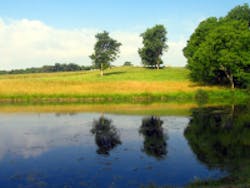WaterWorld Weekly Newscast, December 17, 2018
The following is a transcript for the WaterWorld Weekly Newscast for December 17, 2018.
Hi, I'm Angela Godwin for WaterWorld magazine, bringing you water and wastewater news headlines for the week of December 17. Coming up...
EPA, Army propose new 'Waters of the U.S.' definition
Albuquerque drinking water project celebrates 10 years
Researchers find hurricanes have lasting impact on Puerto Rico’s watershed
Grevatt tapped to lead WRF
Dead zones detected in urban streams
The much-anticipated revised definition of 'Waters of the U.S.' was proposed last week by the U.S. EPA and the Department of the Army.
The agencies believe the proposed definition is "clear, understandable, and implementable" and clarifies federal authority under the Clean Water Act.
Under the agencies’ proposal, federally regulated waters would include traditional navigable waters, tributaries to those waters, certain ditches, certain lakes and ponds, impoundments of jurisdictional waters, and wetlands adjacent to jurisdictional waters.
Features that only contain water during or in response to rainfall; groundwater; many ditches, including most roadside or farm ditches; prior converted cropland; stormwater control features; and waste treatment systems would not be considered 'waters of the United States.'
The agencies plan to hold an informational webcast on January 10, and will host a listening session on the proposed rule in Kansas City, KS, on January 23.
The proposal will be available for public comment for 60 days after publication in the Federal Register.
More information, including a pre-publication version of the Federal Register notice, the supporting analyses and fact sheets, are available at epa.gov/wotus-rule.
Ten years and 137 billion gallons later, the San Juan-Chama Drinking Water Project is delivering on the promise of groundwater rebound for Albuquerque and Bernalillo County.
The project, which cost upwards of $450 million to build, came online in December 2008.
Before that, city and county residents relied solely on the regional aquifer for their municipal water supply.
The San Juan-Chama project changed that by making surface water, imported from southern Colorado since the 1970s, available for consumption.
It required installation of 38 miles of new pipeline; the construction of a riverside diversion, fish passage and pump station; and a 110-acre, $160 million water treatment plant on Albuquerque's north side.
Now, after a decade of operation, groundwater accounts for only about 30 percent of drinking water production, and aquifer levels are up by 50 feet or more in some locations.
Researchers at the University of New Hampshire have found that unprecedentedly high levels of nitrate in Puerto Rico's streams and watersheds have persisted for a year, following two consecutive major hurricanes in 2017.
According to the researchers, elevated nitrate levels are expected immediately following a hurricane, but typically return to base levels within a few months.
However, after Hurricanes Irma and Maria, in August and September 2017, respectively, the increase in nitrate levels has not fully recovered.
Base readings have remained higher, and nitrate levels spike after rain events, even small rainstorms.
The researchers are concerned that if this "new normal" continues and the mountain streams transport higher levels of nitrate to the ocean, it could disrupt the coastal ecosystem.
Soon, the director of EPA's Office of Ground Water and Drinking Water will take on a new role.
Dr. Peter Grevatt will become CEO of the Water Research Foundation, taking over for Rob Renner who will be retiring.
Grevatt brings over 30 years of experience to his new position. In is role at EPA, he was involved with the development and implementation of national drinking water standards, oversight and funding of state drinking water programs, and the implementation of source water protection and underground injection control programs.
He will begin his new position in February.
A new study led by Duke University finds that hypoxic dead zones not only occur in coastal waters but also in freshwater urban streams.
The research team measured dissolved oxygen concentrations, light levels, water chemistry and stream flow in six streams draining urban watersheds in Durham and Raleigh, N.C., from 2015 to 2017.
They found that runoff from intense storms can erode urban streams, dramatically changing their shape, such that water can stop flowing in them during late summer.
The resulting pools contain high levels of nutrients and organic matter, spurring bacteria to consume more dissolved oxygen, and causing the pools to become hypoxic until they can be flushed out by a subsequent storm.
The researchers worry that it "paints a bleak picture" for freshwater organisms living in urban streams.
For WaterWorld magazine, I'm Angela Godwin. Thanks for watching.
